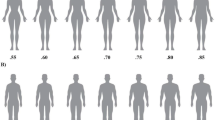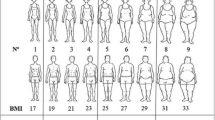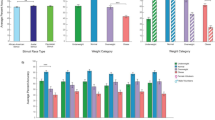Abstract
The western consensus is that obese women are considered attractive by Afro-Americans and by many societies from nonwestern developing countries. This belief rests mainly on results of nonstandardized surveys dealing only with body weight and size, ignoring body fat distribution. The anatomical distribution of female body fat as measured by the ratio of waist to hip circumference (WHR) is related to reproductive age, fertility, and risk for various major diseases and thus might play a role in judgment of attractiveness. Previous research (Singh 1993a, 1993b) has shown that in the United States Caucasian men and women judge female figures with feminine WHRs as attractive and healthy. To investigate whether young Indonesian and Afro-American men and women rate such figures similarly, female figures representing three body sizes (underweight, normal weight, and overweight) and four WHRs (two feminine and two masculine) were used. Results show that neither Indonesian nor Afro-American subjects judge overweight figures as attractive and healthy regardless of the size of WHR. They judged normal weight figures with feminine WHRs as most attractive, healthy, and youthful. The consensus on women’s attractiveness among Indonesian, Afro-American, and U.S. Caucasian male and female subjects suggests that various cultural groups have similar criteria for judging the ideal woman’s shape.
Similar content being viewed by others
References
Anderson, J. L., C. B. Crawford, J. Nadeau, and T. Lindberg 1992 Was the Duchess of Windsor Right? A Cross-Cultural Review of the Socioecological of Ideals of Female Body Shape.Ethology and Sociobiology 13:197–227.
Beall, C. M., and M. C. Goldstein 1992 High Prevalence of Excess Fat and Central Patterning among Mongolian Pastoral Nomads.American Journal of Human Biology 4:747–756.
Björntorp, P. 1988 The Associations between Obesity, Adipose Tissue Distribution and Disease.Acta Medica Scandinavica (Supplement) 723:121–134.
1993 Visceral Obesity: A “Civilization Syndrome.”Obesity Research 1:206–222.
Bray, G. A. 1987 Overweight Is Risking Fate: Definition, Classification, Prevalence, and Risks. InHuman Obesity, R. J. Wurtman and J. J. Wurtman, eds. Pp. 14–28. New York: New York Academy Press.
Brink, P. J. 1989 The Fattening Room among the Annang of Nigeria.Medical Anthropology 12:131–143.
Brown, P. J., and M. Konner 1987 An Anthropological Perspective on Obesity. InHuman Obesity, R. J. Wurtman and J. J. Wurtman, eds. Pp. 29–46. New York: New York Academy Press.
Buss, D. M. 1987 Sex Differences in Human Mate Selection: An Evolutionary Perspective. InSociobiology and Psychology: Ideas, Issues, and Application, C. Crawford, M. Smith, and D. Krebs, eds. Pp. 335–351. Hillsdale, New Jersey: Lawrence Erlbaum Associates.
1994The Evolution of Desire: Strategies of Human Mating. New York: Basic Books.
Cronk, C. E., and A. F. Roache 1982 Race- and Sex-specific Reference Data for Triceps and Subscapular Skinfold and Weight/stature.American Journal of Clinical Nutrition 35:347–354.
Davison, H. L. 1983Multidimensional Scaling. New York: Wiley.
Ford, C. S., and F. A. Beach 1951Patterns of Sexual Behavior. New York: Harper.
Frisch, R. E. 1990 Body Fat, Menarche, Fitness and Fertility. InAdipose Tissue and Reproduction, R. E. Frisch, ed. Pp. 1–26. Basal, Switzerland: Karger.
Harris, M. B., L. C. Walters, and S. Waschull 1991 Gender and Ethnic Differences in Obesity-related Behaviors and Attitudes in a College Sample.Journal of Applied Psychology 21:1545–1577.
Kruskal, J. B., and M. Wish 1978Multidimensional Scaling. Beverly Hills: Sage.
National Academy of Sciences 1991Diet and Health. Washington, D.C.: National Academy of Sciences Press.
SAS Institute, Inc. 1985SAS User’s Guide: Statistics, Version 5 Edition. Carey, North Carolina: SAS Institute.
Singh, D. 1993a Adaptive Significance of Female Physicial Attractiveness: Role of Waist-to-hip Ratio.Journal of Personality and Social Psychology 65:293–307.
1993b Body Shape and Women’s Attractiveness: The Critical Role of Waist-to-hip Ratio.Human Nature 4:297–321.
1994 Body Fat Distribution and Perception of Desirable Female Body Shape by Young Black Men and Women.International Journal of Eating Disorders 16:289–294.
n.d. Waist-to-hip Ratio: Indicator of Female Health, Fecundity, and Physical Attractiveness. Unpublished manuscript.
Sobal, J., and A. J. Stunkard 1989 Socioeconomic Status and Obesity: A Review of the Literature.Psychological Bulletin 105:260–275.
Symons, D. 1979The Evolution of Human Sexuality. Oxford: Oxford University Press.
Williams, G. C. 1966Adaptation and Natural Selection. Princeton, New Jersey: Princeton University Press.
Author information
Authors and Affiliations
Additional information
Devendra Singh is an associate professor of psychology in the Behavioral Neuroscience Program at the University of Texas at Austin. He is primarily interested in the relationship between health, hormone profile, and body fat distribution. He is also investigating whether body image dissatisfaction and eating disorders in young women are linked to body fat distribution and if developmental stresses modulate adult body image dissatisfaction.
Suwardi Luis received a B.A. (Honors) in Psychology from the University of Texas at Austin and is presently enrolled in the MBA program at Texas A&M University. In his honor’s thesis Luis used photographs to investigate the relative role of faces and body shapes (WHR) in judgment of female attractiveness, youthfulness, and desirability for romantic relationships.
Rights and permissions
About this article
Cite this article
Singh, D., Luis, S. Ethnic and gender consensus for the effect of waist-to-hip ratio on judgment of women’s attractiveness. Human Nature 6, 51–65 (1995). https://doi.org/10.1007/BF02734135
Received:
Accepted:
Issue Date:
DOI: https://doi.org/10.1007/BF02734135




